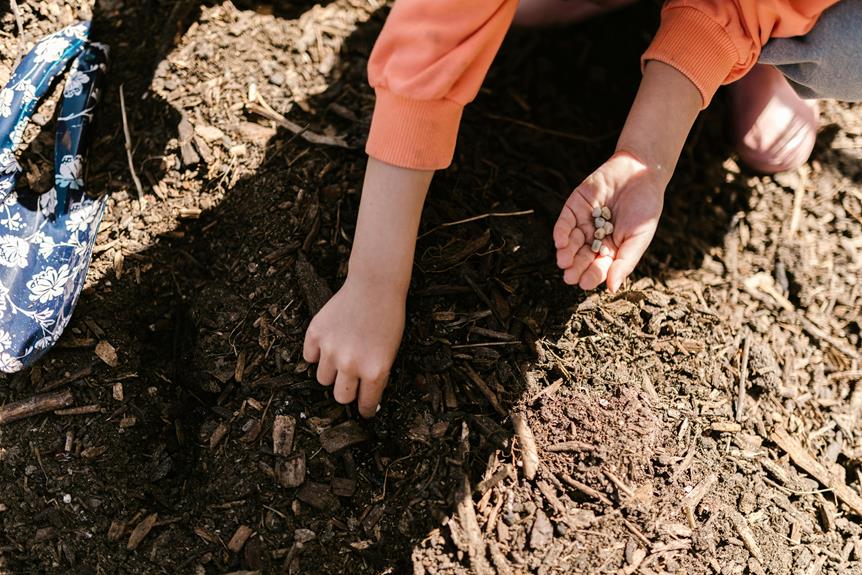
When composting in your garden, ensure you mix green materials like fruit scraps with brown materials such as dried leaves in a 2:1 ratio for optimal decomposition. Turn the compost regularly to keep it aerated and check the moisture levels to maintain proper conditions. Utilize the finished compost to nourish your garden beds by spreading a layer or mixing it into the soil before planting. Enhance your gardening experience by following these best practices.
Choosing the Right Materials
When starting your compost pile, what materials should you consider using to ensure successful decomposition? The key to a thriving compost pile lies in the balance of green and brown materials.
Green materials, such as fruit scraps, vegetable peels, and grass clippings, are rich in nitrogen and provide the necessary nutrients for microorganisms to break down the organic matter. On the other hand, brown materials, like dried leaves, straw, and shredded paper, are high in carbon and help create air pockets for proper aeration within the pile.
To kickstart the decomposition process, include a variety of green and brown materials in your compost pile. Aim for a mix of roughly two-thirds brown materials to one-third green materials by volume. This ratio will ensure that your compost pile has the right blend of nutrients and airflow to support the activities of the beneficial bacteria and fungi responsible for decomposition.
Remember to chop or shred larger materials to accelerate the breakdown process and turn your compost pile regularly to promote even decomposition throughout. By selecting the right materials and maintaining a balanced mix, you can create nutrient-rich compost for your garden while reducing waste effectively.
Achieving the Proper Balance
To achieve the proper balance in your compost pile, focus on maintaining the right ratio of green to brown materials for optimal decomposition. Green materials, such as grass clippings, fruit and vegetable scraps, and coffee grounds, are rich in nitrogen. Brown materials, like dried leaves, straw, and wood chips, provide carbon. The ideal ratio is roughly 2 parts green to 1 part brown. This balance ensures that there's enough nitrogen to feed the microorganisms responsible for breaking down the organic matter, while the carbon helps create the necessary airflow by preventing the pile from compacting.
When adding materials to your compost pile, layer them in alternating green and brown sections to promote even decomposition. Chop or shred larger pieces to accelerate the process. Keep the pile moist but not waterlogged, as the microorganisms need moisture to thrive. Turning the pile regularly helps aerate it and distribute moisture and nutrients evenly. By maintaining this balance of green and brown materials and providing the right conditions, you can speed up the composting process and create nutrient-rich compost for your garden.
Maintaining the Compost Pile
To maintain your compost pile effectively, consider implementing routine maintenance tasks to ensure optimal decomposition and nutrient-rich compost for your garden.
Regularly turning the compost pile with a pitchfork or shovel helps aerate the materials, promoting the breakdown process by providing oxygen to the microorganisms responsible for decomposition. This turning also helps distribute moisture evenly throughout the pile, preventing dry spots that can slow down decomposition.
Monitoring the moisture levels is crucial; the compost should be as damp as a wrung-out sponge. Add water when needed to maintain the right moisture balance.
Keep an eye on the temperature of the compost pile as well. Ideally, the internal temperature should range between 110-140°F (43-60°C). If the temperature is too low, the decomposition process slows down, while excessively high temperatures can kill beneficial microorganisms. Adjust the pile's size and composition by adding more brown materials like dried leaves or cardboard to reduce the temperature or adding more green materials like kitchen scraps to increase it.
Utilizing the Finished Compost
Once the compost has fully decomposed and reached a dark, crumbly texture, it's time to incorporate it into your garden soil to enhance fertility and promote plant growth. Spread the finished compost evenly over your garden beds or mix it into the soil before planting. This rich organic matter will improve soil structure, retain moisture, and provide essential nutrients for your plants.
When using finished compost, apply a layer that's about 1-2 inches thick on the soil surface. Avoid piling the compost against plant stems or trunks to prevent rot and disease. For potted plants, mix compost into the potting soil or use it as a top dressing to enrich the existing soil.
Remember to continue regular watering to help the compost integrate with the soil and support microbial activity. Over time, the compost will further break down, releasing nutrients gradually for sustained plant growth. By utilizing finished compost effectively, you're recycling organic waste and creating a healthier environment for your garden to thrive.




